Thai Chicken and Ginger Noodles: The Ultimate Guide
Thai Chicken and Ginger Noodles is a dish that embodies the rich, bold, and balanced flavors of Thailand’s street food culture. At JustThaiRecipes, our passion for Thai cuisine comes alive in every recipe we share. As Lina explains on our About page, the blog began as a labor of love. It was fueled by our desire to make authentic Thai flavors approachable for home cooks everywhere. With each post, we aim to bridge the gap between traditional Thai cooking and modern kitchens worldwide.
In this guide, we’ll take you through everything you need to master Thai Chicken and Ginger Noodles at home—from selecting the freshest ingredients to mastering wok techniques. Along the way, you’ll discover variations like Authentic Thai Ginger Chicken Stir-Fry and even tips inspired by BBC Good Food for Western adaptations. Whether you’re a beginner or an experienced cook, this recipe will help you bring Thailand’s flavors to your table.
Table of Contents
Table of Contents
Understanding Thai Chicken and Ginger Noodles
What Makes Thai Chicken and Ginger Noodles Special?
When people think of Thai stir-fries, they often envision Pad Thai or Pad See Ew. But Thai Chicken and Ginger Noodles offers something different. The fragrant punch of julienned ginger blends perfectly with tender chicken thighs, earthy mushrooms, and silky rice noodles, all coated in a savory-sweet sauce. This isn’t just another noodle dish it’s a celebration of balance: salty from fish sauce, sweet from soy, and umami from oyster sauce.
Unlike Chinese stir-fries, which often rely heavily on soy-based sauces, this Thai dish leans on fish sauce and white pepper for depth. It’s lighter on oil but richer in aroma, thanks to fresh herbs and spices.
The Role of Ginger in Thai Cooking
In Thailand, ginger isn’t just an ingredient—it’s medicine, garnish, and flavor powerhouse. Fresh ginger brings a peppery heat and floral aroma that enhances chicken’s natural sweetness. It also aids digestion, making it a thoughtful addition to heavier dishes like noodle stir-fries.
When julienned finely, ginger melts into the dish, releasing its oils and infusing every bite. This technique, often overlooked in Western adaptations, is essential for achieving an authentic Thai chicken and ginger noodles recipe.
Ingredients Deep Dive
Choosing the Right Chicken for Stir-Fry
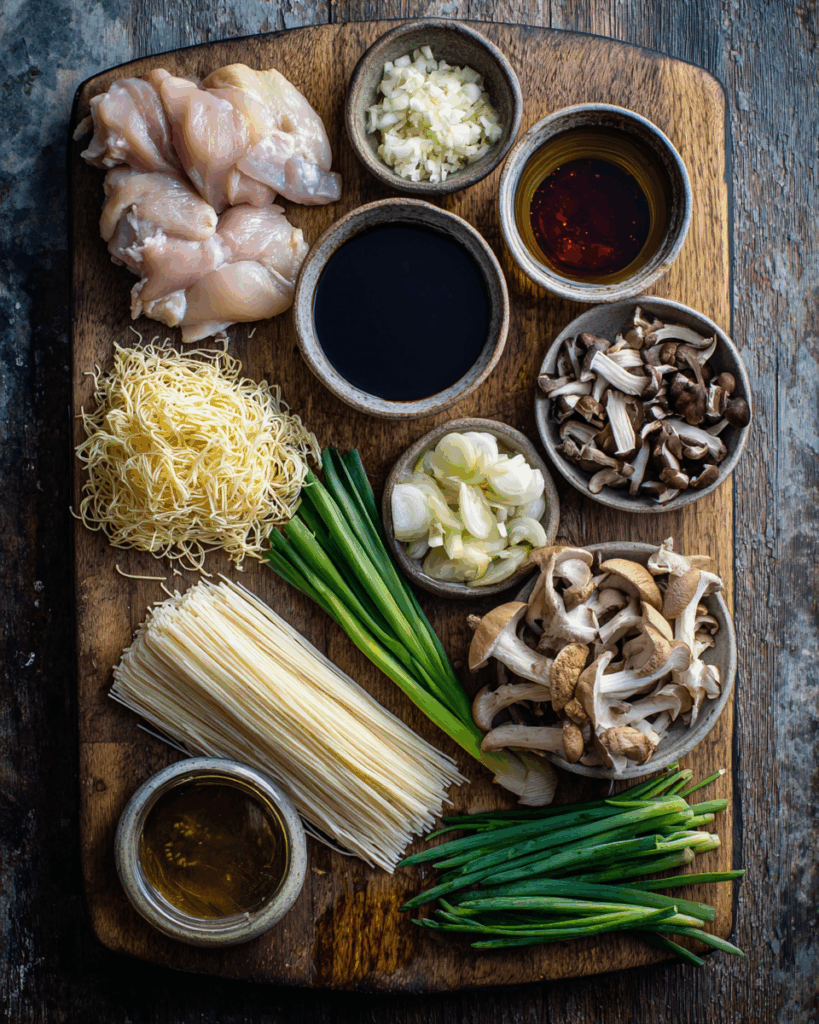
The foundation of any great stir-fry is its protein, and for Thai Chicken and Ginger Noodles, chicken thighs are king. Unlike breast meat, thighs stay juicy and tender even under the intense heat of a wok. Their slightly higher fat content allows them to absorb more flavor from marinades and sauces, giving the final dish a richer mouthfeel.
To prepare, thinly slice 400g (14 oz) of chicken thighs against the grain. This ensures quicker cooking and better absorption of the dark sweet soy sauce and ground white pepper marinade. Marinate for at least 10 minutes to let the flavors penetrate deeply.
Pro Tip: For even more authenticity, use free-range chicken for a more succulent texture.
Understanding the Flavor Builders
The harmony in Thai chicken noodles stir-fry comes from its sauces and seasonings. Here’s a breakdown of each:
- Dark Sweet Soy Sauce (1 tsp): Adds a molasses-like sweetness and deep color to the chicken.
- Fish Sauce (1 tbsp): Brings umami depth and a subtle briny flavor.
- Oyster Sauce (¼ cup): The backbone of the sauce, giving the dish a glossy, rich finish.
- Ground White Pepper (½ tsp): Offers a milder, earthier heat compared to black pepper.
- Sugar (1 tsp): Balances out the salty and umami notes, crucial for authentic Thai flavor.
This trifecta of sauces creates a layered taste profile that’s distinctly Thai, standing apart from Chinese versions like Thai chicken and ginger noodles Chinese stir-fries.
Cooking Equipment and Preparation Tips
The Importance of a Wok in Thai Stir-Fry
A wok isn’t just a pan—it’s a vessel for flavor. Its curved sides and high heat capacity allow for rapid cooking and easy tossing, ensuring every ingredient gets seared without steaming.
If you don’t have a wok, a large frying pan can work in a pinch, but avoid overcrowding to prevent sogginess. Keep the heat high and the oil (2 tbsp vegetable oil) minimal to maintain that signature Thai stir-fry texture.
Preparing Your Ingredients Like a Thai Chef
Mise en place—having all your ingredients prepped and ready—is vital. Thai cooking moves fast, and pausing mid-stir-fry to chop garlic or julienne ginger is a recipe for disaster.
- Garlic (3 cloves): Roughly chop to release its oils without burning.
- Onion (1): Slice into wedges to add sweetness and texture.
- Ginger (40g): Julienne finely so it melds seamlessly into the stir-fry.
- Mushrooms (150g): Use a mix like shiitake and wood ear for a variety of textures and flavors.
- Rice Stick Noodles (150g): Soak or boil until just tender to avoid overcooking in the wok.
- Spring Onions (3): Cut into batons for a fresh, oniony bite at the end.
Step-by-Step Cooking Process
Stir-Fry Basics for Beginners
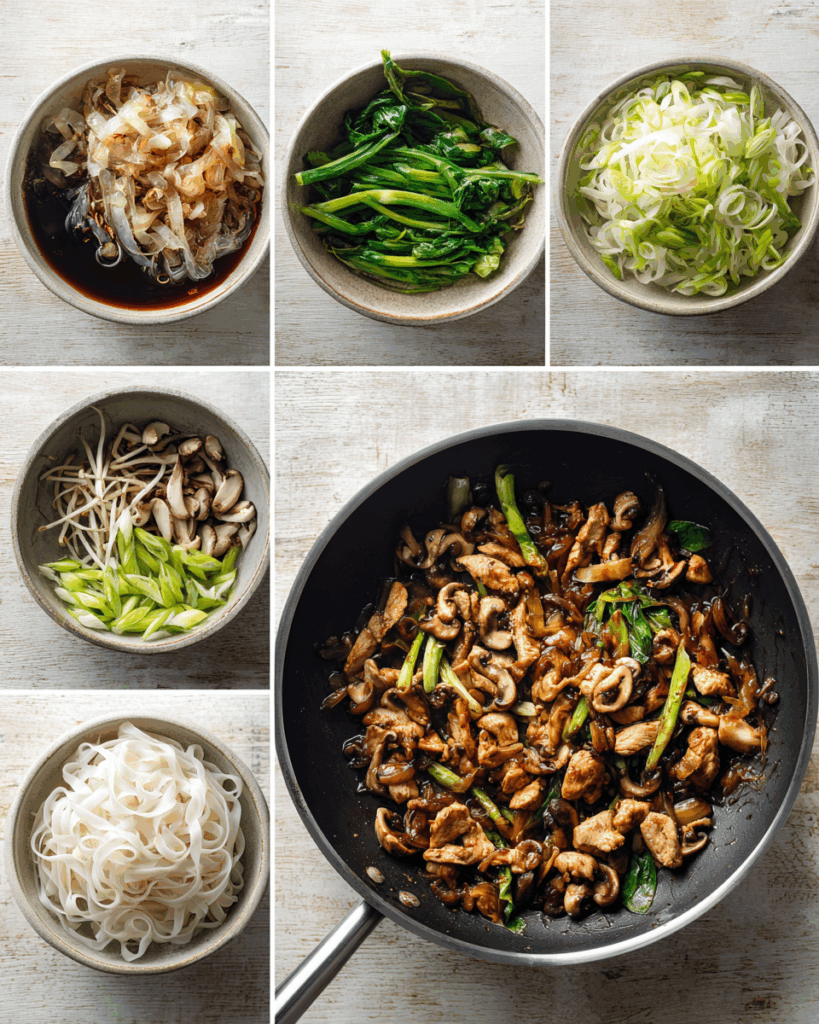
Mastering a Thai stir-fry starts with understanding the rhythm of high-heat cooking. Every step happens fast, so preparation is key. Here’s how to nail it:
- Marinate the Chicken: Combine thinly sliced chicken thighs with 1 tsp dark sweet soy sauce and ½ tsp ground white pepper. Set aside for at least 10 minutes.
- Mix the Sauce: In a separate bowl, blend ¼ cup oyster sauce, 1 tbsp fish sauce, and 1 tsp sugar until dissolved.
- Boil Water for Noodles: Get your pot ready on high heat. You’ll cook your rice stick noodles here later.
Don’t miss our Coconut Mango Chicken Curry for another fusion take on Thai classics.
Detailed Cooking Steps Explained
- Heat 2 tbsp vegetable oil in a wok over high heat.
- Add 3 roughly chopped garlic cloves and 1 sliced onion. Stir-fry for 30 seconds until fragrant.
- Toss in the marinated chicken. Stir-fry until almost cooked.
- Add 40g finely julienned ginger and 150g mixed mushrooms. Cook for 1 more minute until the mushrooms start to wilt.
- Turn off the heat temporarily while you cook your noodles in boiling water for 2 minutes. Drain well.
- Add the noodles back into the wok, turn the heat back on high, pour in your sauce mix, and toss until everything is coated.
- Stir through 3 spring onions cut into batons and serve immediately.
Pro Tip: Keep tossing to avoid burning and ensure even distribution of sauces.
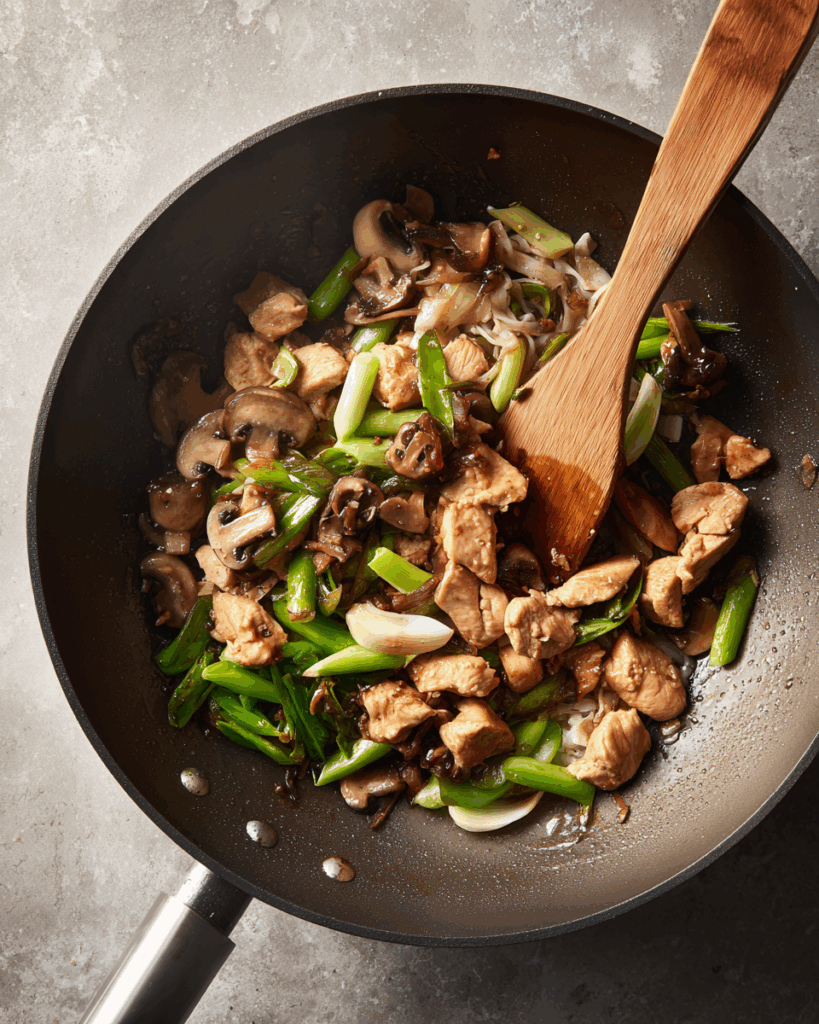
Looking for inspiration? Try Fried Chicken in Sweet Chili Lime Sauce for another bold Thai stir-fry.
Variations of Thai Chicken and Ginger Noodles
Authentic Thai Chicken and Ginger Noodles Recipe
The traditional version of this dish keeps it simple yet bold. It’s all about letting the aromatics shine. In the authentic Thai chicken and ginger noodles recipe, rice stick noodles are stir-fried with tender chicken thighs, fresh julienned ginger, mushrooms, and spring onions. The sauce leans on classic Thai staples: fish sauce, oyster sauce, and a touch of sugar.
For maximum authenticity, use Thai fish sauce and dark sweet soy sauce imported from Thailand. This ensures the flavor profile mirrors what you’d experience in a Bangkok street market. Serve with extra fresh chili slices on the side for added heat.
Authentic Thai Ginger Chicken Recipe (No Noodles)
Known in Thailand as “Gai Pad King,” this variation skips the noodles entirely. Instead, the focus shifts to chicken stir-fried with ginger, mushrooms, onions, and spring onions, served over hot jasmine rice. The result is a lighter dish with a more concentrated ginger flavor.
This is perfect for anyone looking for a low-carb option or a dish closer to what’s served in traditional Thai homes. Pair it with a refreshing drink like our Thai Iced Cocoa Milk for balance.
Thai Chicken and Ginger Noodles BBC Good Food Style
If you’re familiar with BBC Good Food’s version of Thai stir-fry noodles, you’ll notice a few key differences. Their approach caters to Western kitchens:
- Leaner cuts like skinless chicken breast are used.
- A milder sauce with less fish sauce for subtle flavor.
- Additional vegetables such as bell peppers, snap peas, and carrots are added for color and crunch.
- Rice noodles are often swapped for egg noodles or soba noodles for accessibility.
This version is great for weeknight dinners where you want a balance of health and flavor.
Thai Chicken and Ginger Noodles Chinese-Inspired Version
Although a Thai dish, you can give it a Chinese stir-fry twist by:
- Using Chinese egg noodles instead of rice noodles.
- Adding light soy sauce and sesame oil to the sauce mix.
- Including Chinese vegetables like bok choy or Chinese broccoli.
This hybrid style resembles Cantonese chow mein but still carries the warmth of Thai ginger and fish sauce. It’s a wonderful way to explore cross-cultural flavors.
Thai Chicken Noodles Stir-Fry
This variation focuses less on ginger and more on creating a broader noodle stir-fry base. Think chicken, rice noodles, colorful vegetables, and a sauce that’s heavier on soy and oyster sauce. For added texture, toss in a handful of bean sprouts at the end.
It’s a quick, satisfying weeknight meal that leans more towards the “comfort food” side of Thai cuisine.
Thai Ginger Chicken Stir-Fry Recipe (Vegetarian-Friendly)
For a vegetarian or vegan twist, swap out chicken for tofu or tempeh. Replace fish sauce with soy sauce or vegan fish sauce alternatives. Load up with a variety of mushrooms—shiitake, oyster, and enoki work beautifully—and add bell peppers for sweetness.
This stir-fry shines on its own with jasmine rice or as a topping for rice noodles.
Looking for inspiration? Try our Fried Chicken in Sweet Chili Lime Sauce for a sweet and spicy alternative.
Pairings and Serving Suggestions
What to Serve With Thai Chicken and Ginger Noodles
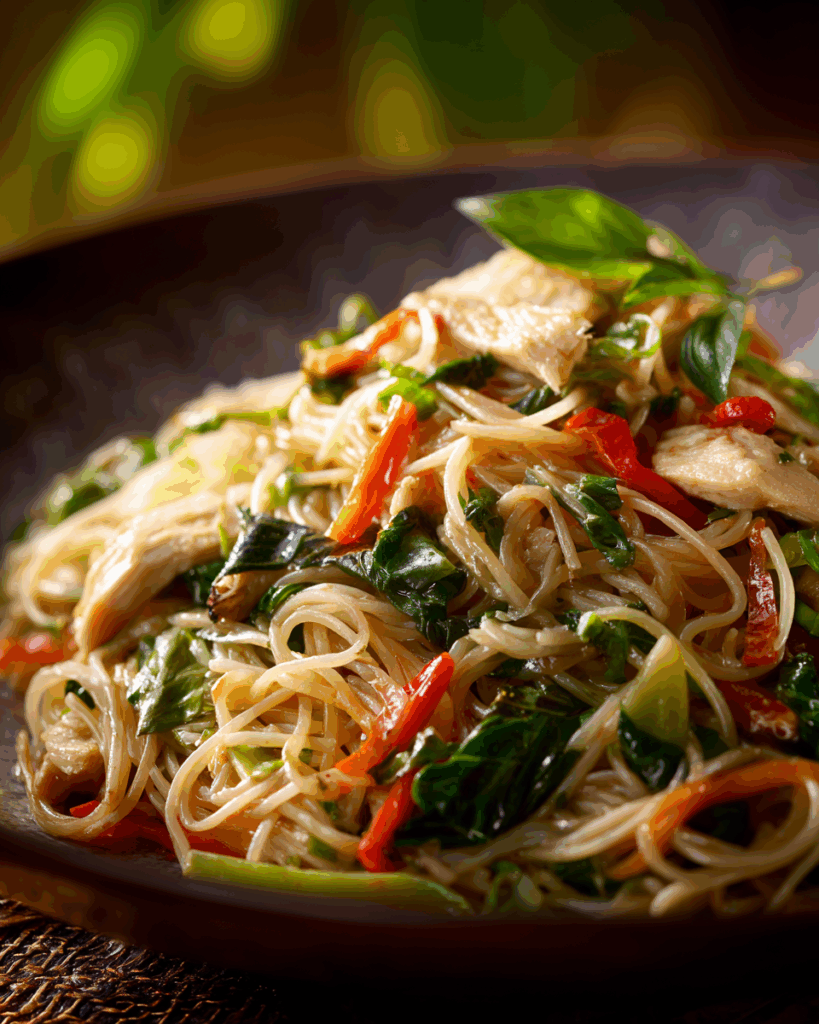
This stir-fry is a standalone meal, but pairing it thoughtfully elevates the dining experience. Here are some ideas:
- Refreshing Drinks: Complement the warmth of the noodles with a glass of Thai Iced Cocoa Milk. Check out our recipe here for a creamy, sweet counterbalance.
- Light Starters: Begin with a Thai papaya salad for a crisp, tangy start.
- Perfect Dessert: Cap off the meal with Thai Mango Sticky Rice. It’s an iconic pairing of creamy coconut, sweet mango, and sticky rice. Discover our Mango Sticky Rice guide.
Garnishes That Elevate Your Dish
Small additions can transform the presentation and taste:
- Sprinkle toasted sesame seeds for added nuttiness.
- Garnish with fresh coriander or Thai basil for herbal brightness.
- Add sliced red chili for a kick of heat and visual appeal.
For another flavor-packed variation, explore Spicy Thai Chicken and Veggie Noodles by Jo Cooks. It’s a great option for spice lovers seeking extra heat.
Tips for Storing and Reheating
Best Practices for Leftovers

If you’re lucky enough to have leftovers, proper storage keeps them delicious:
- Refrigeration: Store in an airtight container for up to 3 days.
- Avoid Clumping: Drizzle a teaspoon of sesame oil before storing to prevent the noodles from sticking.
When reheating, use a wok or skillet over medium heat rather than a microwave. This revives the dish’s texture and avoids soggy noodles.
Freezing Thai Chicken and Ginger Noodles
Freezing isn’t ideal as rice noodles can turn mushy. However, you can freeze the cooked chicken and vegetables separately. When ready to eat, prepare fresh noodles and stir-fry everything together.
Nutritional Information and Health Benefits
Breaking Down the Macros
Here’s a rough nutritional estimate per serving:
| Nutrient | Amount |
|---|---|
| Calories | 450 kcal |
| Protein | 25g |
| Carbohydrates | 55g |
| Fats | 15g |
| Fiber | 3g |
| Sodium | 780mg |
This makes it a moderate-calorie, protein-rich meal suitable for a balanced diet.
Health Benefits of Thai Ingredients
- Ginger: Anti-inflammatory properties and aids digestion.
- Garlic: Boosts immunity and supports heart health.
- Mushrooms: Low-calorie and rich in antioxidants.
Want to try a homemade Pad Thai twist with ginger chicken? Visit Homemade Ginger Chicken Pad Thai by Murmurs of Ricotta for a creative fusion approach.
Common Mistakes and How to Fix Them
Overcooking Chicken or Noodles
One of the most common pitfalls in stir-fry cooking is overcooking. To avoid rubbery chicken:
- Cook chicken in small batches on high heat.
- Don’t leave noodles in boiling water longer than 2 minutes.
Balancing Flavors the Thai Way
If your dish feels too salty, add a splash of water and a pinch of sugar. If it’s too bland, increase the fish sauce or add a squeeze of lime juice for acidity.
Looking for more Thai culinary tips? Explore the BBC Good Food ME site for inspiration here.
Why Thai Chicken and Ginger Noodles Deserve a Spot in Your Weekly Menu
If you’re searching for a meal that combines flavor, speed, and comfort, Thai Chicken and Ginger Noodles deserves your attention. This dish isn’t just another stir-fry; it’s a reflection of Thailand’s culinary mastery, where every ingredient has a purpose and every step delivers maximum taste.
Unlike heavier noodle dishes, Thai Chicken and Ginger Noodles are light yet satisfying. The chicken thighs offer juicy tenderness that pairs beautifully with the bright bite of julienned ginger. Together with earthy mushrooms and silky rice stick noodles, every bite is layered with umami richness and subtle heat.
Cooking Thai Chicken and Ginger Noodles is also incredibly approachable. With a short list of easy-to-find ingredients, even novice home cooks can create a dish that tastes like it came straight from a Bangkok street vendor. All you need is a wok or large skillet, high heat, and about 30 minutes.
The real magic of Thai Chicken and Ginger Noodles lies in the sauce. A blend of oyster sauce, fish sauce, and dark sweet soy sauce creates a glossy coating that clings perfectly to the noodles. This sauce not only seasons the chicken but also enhances the natural sweetness of the onions and the mild spice of the ginger.
What makes this dish even more versatile is its adaptability. Whether you want a vegetarian version with tofu and extra mushrooms or a spicier rendition with Thai bird’s eye chilies, Thai Chicken and Ginger Noodles can be adjusted to suit any palate.
Make it part of your weeknight rotation, and you’ll find that Thai Chicken and Ginger Noodles satisfy cravings for something quick, healthy, and deeply flavorful. Plus, leftovers (if there are any) reheat beautifully, making lunch the next day an event to look forward to.
So, if you’re ready to step up your stir-fry game, there’s no better place to start than with Thai Chicken and Ginger Noodles.
Conclusion
Thai Chicken and Ginger Noodles is more than just a quick stir-fry; it’s a dish that embodies the soul of Thai cooking. With its harmonious blend of savory, sweet, and aromatic notes, it brings the vibrant flavors of Thailand straight to your kitchen. Whether you choose the authentic version served with rice noodles, a vegetarian twist with tofu, or a spicier Chinese-inspired style, there’s a variation for every palate.
This recipe is also incredibly versatile. From weeknight dinners to meal prep lunches, Thai Chicken and Ginger Noodles adapts to your schedule and dietary preferences. And with just a handful of fresh ingredients and a few pantry staples, you’re only 30 minutes away from a restaurant-quality meal at home.
So why wait? Gather your ingredients, fire up your wok, and let Thai Chicken and Ginger Noodles take you on a flavor journey you’ll want to repeat week after week.
For more Thai cooking inspiration, don’t miss our other classics like Coconut Mango Chicken Curry and Fried Chicken in Sweet Chili Lime Sauce.
FAQs
What are the health benefits of Thai Chicken and Ginger Noodles?
Thai Chicken and Ginger Noodles is not only delicious but also packed with nutrients. Ginger provides anti-inflammatory and digestive benefits, while garlic offers heart-healthy compounds. Chicken thighs bring high-quality protein, and mushrooms add antioxidants and fiber. Using rice noodles keeps the dish gluten-free, making it suitable for many dietary needs.
By controlling the oil and sauces used, you can create a version of Thai Chicken and Ginger Noodles that’s lighter and healthier without sacrificing its signature flavors.
Can I prepare Thai Chicken and Ginger Noodles ahead of time?
Yes, Thai Chicken and Ginger Noodles is a great make-ahead meal. You can prep all your ingredients (slice chicken, julienne ginger, mix sauces, and chop vegetables) up to a day in advance. Store them in airtight containers in the refrigerator.
When ready to serve, cook the noodles and stir-fry everything fresh for the best texture and flavor. If you need to reheat leftovers, a quick toss in a hot wok or skillet is ideal to avoid mushy noodles.
How spicy are Thai Chicken and Ginger Noodles?
Traditionally, Thai Chicken and Ginger Noodles aren’t very spicy. The dish focuses more on the aromatic heat of ginger and the savory depth of fish sauce and oyster sauce. However, spice lovers can easily dial up the heat by adding sliced Thai bird’s eye chilies, chili flakes, or a spoonful of Thai chili paste (nam prik pao).
For a milder version suitable for families or spice-sensitive diners, omit the chilies entirely and focus on the warming zing of fresh ginger.
Can I make Thai Chicken and Ginger Noodles vegetarian or vegan?
Yes, you can easily turn Thai Chicken and Ginger Noodles into a vegetarian or vegan meal. Replace the chicken thighs with firm tofu or tempeh to retain the protein content. For the sauces, swap out oyster sauce and fish sauce with vegetarian versions or use soy sauce mixed with a dash of lime for a similar salty-umami balance.
Adding more vegetables like bok choy, bell peppers, and snow peas will bulk up the dish while maintaining its authentic flavors. Mushroom varieties such as shiitake, enoki, and king oyster can enhance the meaty texture, creating a satisfying plant-based version of Thai Chicken and Ginger Noodles.
What type of noodles is best for Thai Chicken and Ginger Noodles?
The best choice for Thai Chicken and Ginger Noodles is medium-width rice stick noodles. These noodles are soft yet chewy, allowing them to soak up the flavorful sauce without breaking apart. Unlike egg noodles or wheat-based alternatives, rice stick noodles offer an authentic texture and taste that complements the bold ginger and tender chicken perfectly.
If rice noodles aren’t available, flat rice noodles (like those used in Pad Thai) are a good substitute. For a unique twist, you can even experiment with soba or zucchini noodles, though these will slightly change the dish’s texture and flavor.
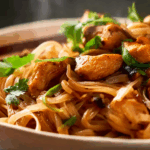
Thai Chicken and Ginger Noodles
- Prep Time: 15 minutes
- Cook Time: 10 minutes
- Total Time: 25 minutes
- Yield: 4 servings 1x
- Category: Main Course
- Method: Stir-Fry
- Cuisine: Asian
- Diet: Low Lactose
Description
A flavorful stir-fried chicken and mushroom dish with tender rice noodles, coated in a savory sauce and infused with garlic, ginger, and spring onions. Perfect for a quick and satisfying meal.
Ingredients
- 400g (14 oz) chicken thighs, thinly sliced
- 1 tsp dark sweet soy sauce
- ½ tsp ground white pepper
- ¼ cup oyster sauce
- 1 tbsp fish sauce
- 1 tsp sugar
- 2 tbsp vegetable oil
- 3 garlic cloves, roughly chopped
- 1 onion, sliced into wedges
- 4cm piece (about 40g/1.4 oz) finely julienned ginger
- 150g (5 oz) mixed mushrooms (e.g., shiitake and wood ear mushrooms), trimmed and sliced
- 150g (5 oz) rice stick noodles
- 3 spring onions, trimmed and cut into batons
Instructions
- Combine the chicken, dark sweet soy sauce, and ground white pepper in a bowl. Set aside to marinate briefly.
- In a separate bowl, mix together the oyster sauce, fish sauce, and sugar to make the stir-fry sauce.
- Bring a large pot of water to a boil over high heat for cooking the noodles later.
- Heat the vegetable oil in a wok or large frying pan over high heat. Add the garlic and onion and stir-fry for 30 seconds.
- Add the marinated chicken and stir-fry until almost cooked through.
- Add the julienned ginger and sliced mushrooms, stir-fry for an additional minute until the mushrooms begin to soften. Turn off the heat temporarily.
- Cook the rice stick noodles in the boiling water for 2 minutes or until just tender. Drain well.
- Add the cooked noodles to the chicken and mushroom stir-fry. Turn the heat back on to high.
- Pour in the prepared sauce and add the spring onions. Stir-fry everything together until well combined and heated through.
- Serve warm and enjoy.
Notes
- For a vegetarian version, substitute chicken with firm tofu and use vegetarian oyster sauce.
- Use fresh rice noodles if available and skip the boiling step.
- Adjust the spice level by adding sliced chili peppers during stir-frying.
Nutrition
- Serving Size: 1 plate
- Calories: 420
- Sugar: 4g
- Sodium: 950mg
- Fat: 14g
- Saturated Fat: 2.5g
- Unsaturated Fat: 10.5g
- Trans Fat: 0g
- Carbohydrates: 42g
- Fiber: 2g
- Protein: 28g
- Cholesterol: 85mg
Keywords: chicken stir fry, rice noodles, Asian chicken noodle recipe, ginger chicken noodles, quick stir fry dinner

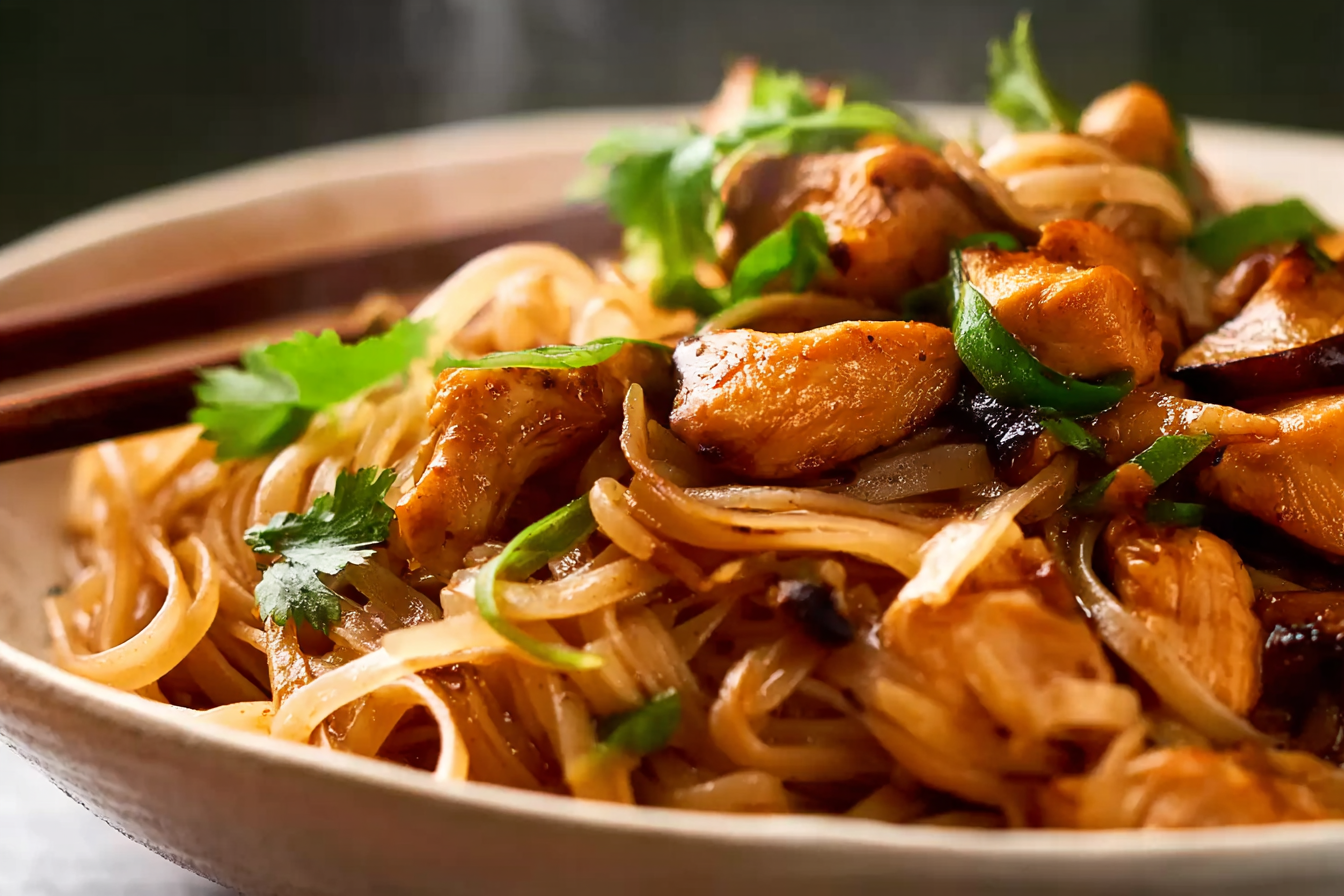
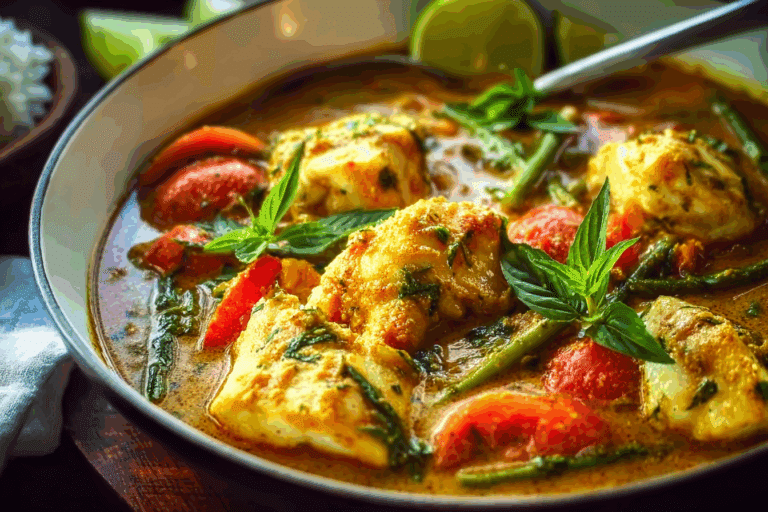
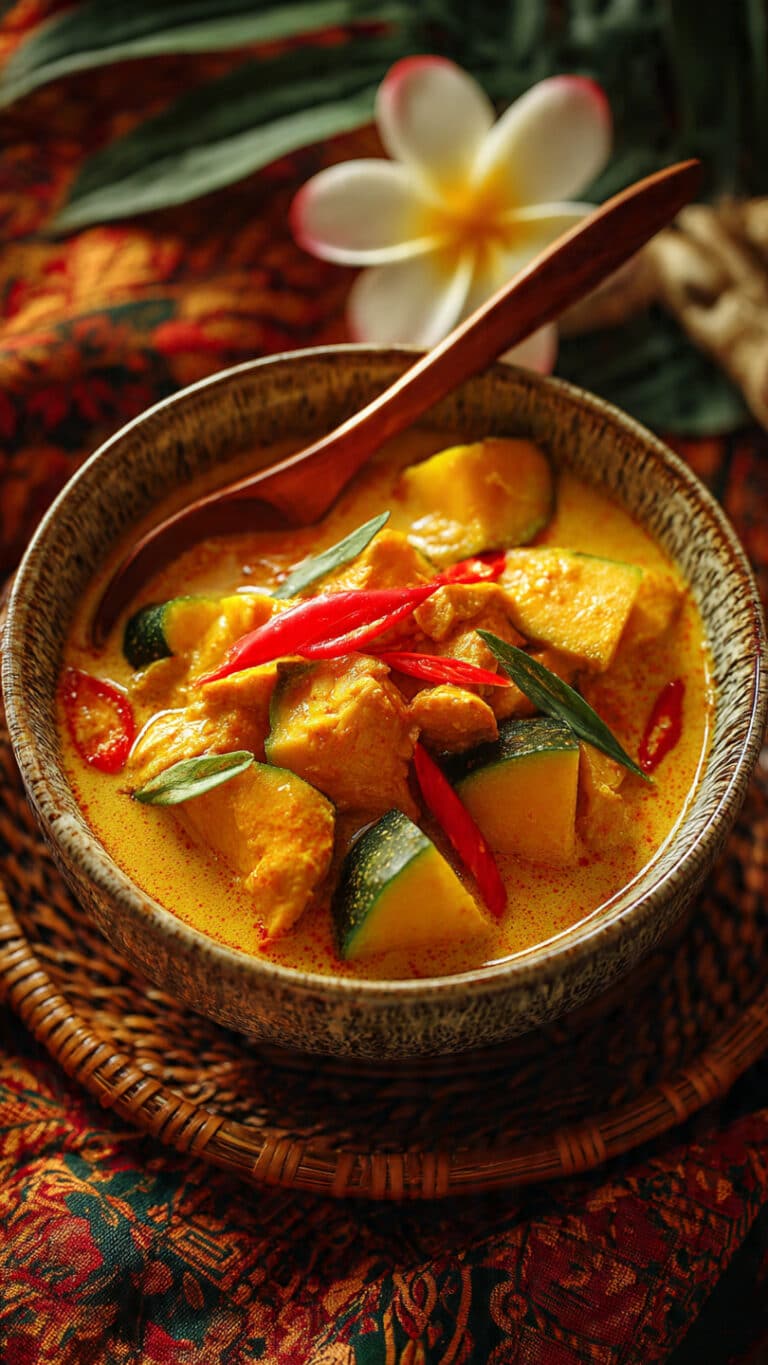
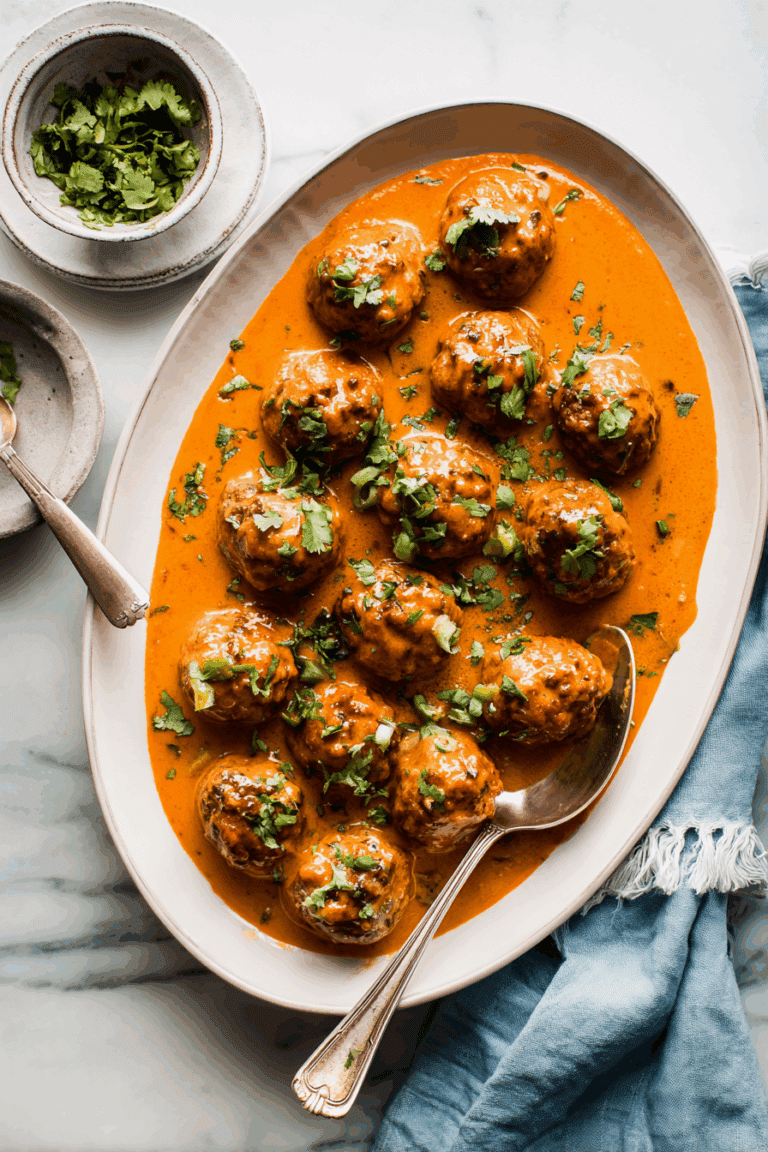
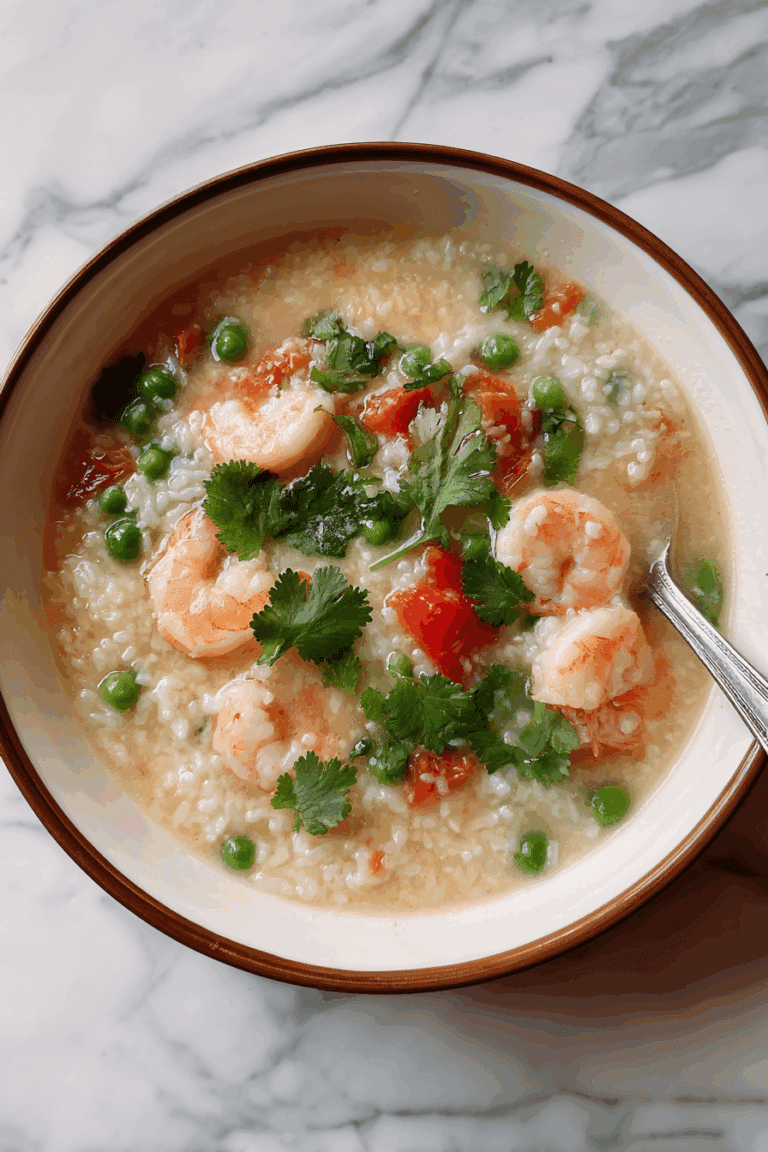

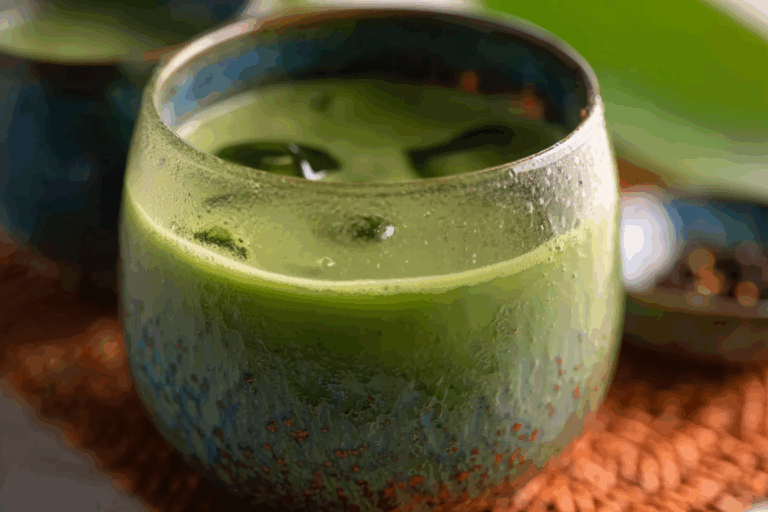
I’m not that much of a internet reader to be honest but your blogs really nice, keep it up! I’ll go ahead and bookmark your website to come back later on. Many thanks